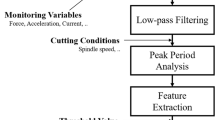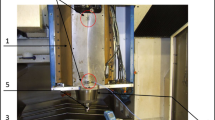Abstract
In modern industry, machinery must become increasingly flexible and automatic. In order to increase productivity, enhance quality and reduce cost, machine tools have to work free of any failure. When a failure occurs in a machine tool, it is necessary to identify the causes as early as possible. Machine tool condition monitoring is very important to achieve this goal. Condition monitoring is generally used on the critical subsystem of any machine tool. This paper endeavors to focus on the condition monitoring aspects on the machine tool element. In the present study, a critical subsystem has been identified based on the failure data analysis. Condition monitoring techniques like vibration monitoring, acoustic emission, Shock Pulse Method (SPM) and surface roughness have been successfully used for fault identification.
Similar content being viewed by others
Abbreviations
- SPM:
-
Shock Pulse Method
References
Kegg RL (1984) On-line machine and process diagnostics. Ann CIRP 32(2):469–478
Bertele OV (1990) Why condition monitor? In: Condition Monitoring, Proceedings of the 3rd International Conference, Windsor, UK, 15–17 October, pp 3–12
Neale MJ (1985) The benefit of condition monitoring. In: Condition monitoring of machinery and plant, Mechanical engineering publications Ltd., The Institution of Engineers, London, pp. 25–30
Martin KF (1994) A review by discussion of condition monitoring and fault diagnosis in machine tools. Int J Mach Tools Manuf 34(4):527–551
Saravanan S, Yadava GS, Rao PV (2003) Machine tool failure data analysis for condition monitoring application. In: Proceedings of the 11th National Conference on Machines and Mechanism, 18–20 December, IIT Delhi, New Delhi, Allied Publishers Pvt. Limited, pp 552–558
Harris CG, Williams JH, Davies A (1989) Condition monitoring of machine tools. Int J Prod Res 27 (9):1945–1964
Wang Y, Jia Y, Yu J, Zheng Y, Yi S (1999) Failure probabilistic model of CNC lathes. Reliab Eng Syst Safety 65(3):307–314
Wang Y, Jia Y, Jiang W (2001) Early failure analysis of machining centres: case study. Reliab Eng Syst Safety 72(1):91–97
Dai Y, Jia Y (2001) Reliability of a VMC and its improvement. Reliab Eng Syst Safety 72(1):99–102
Johansson KE (1981) Field monitoring of NC-machines — a system approach in innovation for maintenance technology improvements. In: Proceedings of the Society for Machinery Failure Prevention Group (MFPG) 33rd Meeting, April
Saravanan S, Yadava GS, Rao PV (2004) Condition monitoring studies on a machine tool element. In: Proceedings of the 3rd International Conference on Advanced Manufacturing Technology (ICAMT 2004), Malaysia, 11–13 May, pp 300–306
Serridge M (1989) Ten crucial concepts behind trustworthy fault detection in machine condition monitoring. In: Proceedings of the 1st International Machinery Monitoring and Diagnostic Conference and Exhibition, Nevada, 11–14 September, pp 722–727
Tandon N (1994) A comparison of some vibration parameters for the condition monitoring of rolling element bearings. Measurement 12(3):285–289
(1990) Section 3: metals test methods and analytical procedures, E61089a, standard terminology relating to acoustic emission. In: Annual Book of ASTM Standards, 03.03, pp 269–271
Dornfeld D (1992) Application of acoustic emission techniques in manufacturing. NDTE Int 25(6):259–269
Holroyd T J and Randall N (1993) Use of acoustic emission for machine condition monitoring. British J. of NDT, 35(2), 75–78.
Chiou RY, Liang SY (2000) Analysis of acoustic emission in chatter vibration with tool wear effect in turning. Int J Mach Tools Manuf 40(7):927–941
Teti R, La Commare U (1992) Cutting conditions and work material state identification through acoustic emission methods. Ann CIRP 41(1):89–92
Miettinen J, Andersson P (2000) Acoustic emission of rolling bearings lubricated with contaminated grease. Tribology Int 33(11):777–787
Ai X (2001) Effect of debris contamination on the fatigue life of roller bearings. In: Proceedings of IMechE, Part J, J Eng Tribology 215:563–575
Miettinen J, Andersson P, Wikström V (2001) Analysis of grease lubrication of a ball bearing using acoustic emission measurement. In: Proceedings of IMechE, Part J, J Eng Tribology 215(6):535–544
Morhain A, Mba D (2003) Bearing defect diagnosis and acoustic emission. In: Proceedings of IMechE, Part J, J Eng Tribology 217(4):257–272
Ho M, Birch DJ, Brunn PJ (2003) Bearing condition assessment, part 1: size and frequency of surface roughness interactions in impulsive vibration measurements. In: Proceedings of IMechE, Part J, J Eng Tribology 217(6):435–445
Lin SC, Chang MF (1998) A study on the effects of vibrations on the surface finish using a surface topography simulation model for turning. Int J Mach Tools Manuf 38(7):763–782
Jang DY, Choi YG, Kim HG, Hsiao A (1996) Study of the correlation between surface roughness and cuttig vibrations to develop an online roughness measuring technique in hard turning. Int J Mach Tools Manuf 36(4):453–464
Konczakowski A, Peklenik J (1984) Turning lathes condition monitoring based on the work piece surface spectral analysis. In: Proceedings of Condition Monitoring ’84, International Conference on Condition Monitoring, 10–13 April, Swansea, pp 279–292
Raja J, Whitehouse DJ (1984) An investigation into the possibility of using surface profiles for machine tool surveillance. Int J Prod Res 22(3):453–466
SKF (1975) General Catalogue, Catalogue 3000 E/GB 666, November, SKF
Grieve DJ (2002) Manufacturing processes — MFRG 315 — 2.6 cutting tools. Available online at http://www.tech.plym.ac.uk/sme/mfrg315/cuttooll.htm, 22 October
Su YT, Lin MH, Lee MS (1993) The effects of surface irregularities on roller bearing vibrations. J Sound Vibr 165(3):455–466
Reeves CW (1998) Machine and systems condition monitoring series: the vibration monitoring handbook, first edition. Coxmoor Publishing Company, Oxford, UK
Author information
Authors and Affiliations
Corresponding author
Rights and permissions
About this article
Cite this article
Saravanan, S., Yadava, G.S. & Rao, P.V. Condition monitoring studies on spindle bearing of a lathe. Int J Adv Manuf Technol 28, 993–1005 (2006). https://doi.org/10.1007/s00170-004-2449-0
Received:
Accepted:
Issue Date:
DOI: https://doi.org/10.1007/s00170-004-2449-0




